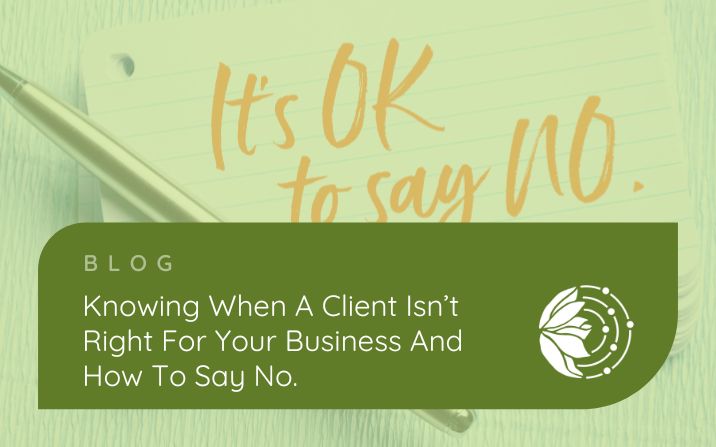When you’re building up your business, the idea of turning work down can seem like a crazy one. There are several reasons why you might need to let a prospective client down, from no availability through to pricing ‘difficulties’.
So what’s the best way to say “No” to a client?
Adjusting your own perspective on matters is your first step. We’re very much within the culture of ‘the customer is always right’ as business owners, but it isn’t always true – particularly with a service based business.
The prospective client has chosen you because you have something to offer, and it’s important to remember that. Your skills, experience and knowledge are valuable assets – so you’re right to be selective about who accesses them. It also means that other people will find you useful, so turning down one client could open the door for many more ideal clients to step through.
Justifying the ‘no’ makes it easier to find the right words when informing your client.
That’s right, it’s important that you feel comfortable with your decision to say no – and that can be the biggest obstacle if you’re new to business. If you have no availability then it’s clear you should say no, but what if you just don’t ‘want’ to? You might have a bad feeling that this project could be a real drain on your time or resources, or perhaps they can’t see the value in what you do and are constantly trying to get more out of you for less?
If the benefits and outcomes of working with a new client don’t leave you and your business in a better position – you are ‘allowed’ to say no. In fact, it’s essential that you say no, so the rest of your business and clients don’t suffer as a result.
One way of weighing up a new client is to have an idea of what your perfect client/project looks like. Consider the work you really enjoy doing now, and the tasks you’d rather leave behind. Weigh up any new requests against this standard – if it falls into the ‘tolerable’ category rather than the ‘enjoyable, you’ll find it a lot easier to say no.
Does the opportunity have potential, or will it be a drain on resources? You must consider every request to work with you from a business perspective, and not a personal one.
Many of us avoid confrontation and so it is easier to email your reasons for saying no in most cases. This also ensures that you can avoid confusion. If it’s down to availability, do let them know when you’ll have room in your diary and perhaps recommend someone else they could work with.
Although you do need to be clear, honest and warm with your reply; you don’t need to be overly apologetic, providing too many details, or encouraging a prolonged conversation.
Imagine you’ve gone into a shop and they’ve run out of what you were looking for – it’s a simple ‘no, sorry we can’t help you today’, and you leave to shop elsewhere. It’s the same with your business too – a simple and polite no is all that’s needed.
If you’re feeling emotional towards this client or situation, write your response but don’t send until you’ve had a chance to check it again with a clear mind. This might mean leaving it a few hours.
Email templates are a great way to tackle difficult customer situations ahead of time.
Being able to write a clear, concise and polite email response to a tricky customer or situation can be difficult at the best of times. So writing them before the need arises can make all the difference. By having templates ready in advance, you can even allow someone else to handle the situation for you – such as your trusted virtual assistant.
A lot of the time we feel unable to say no from a personal level – the fear of turning down work can be quite a challenge, especially if your business is new. You don’t have to stretch yourself too thin to succeed, or be forced into working with clients you’re uncomfortable with. So be sure to thank the customer for the opportunity, but thank yourself for being a good boss too. Your business will thank you for it.

